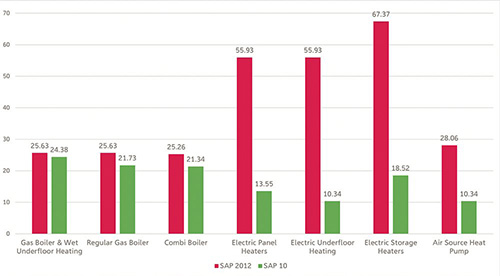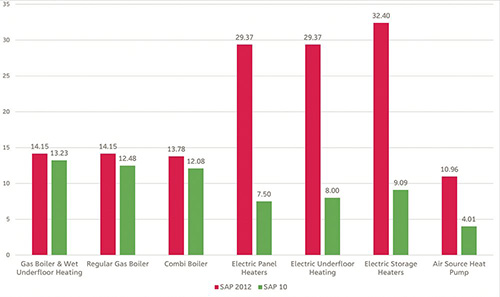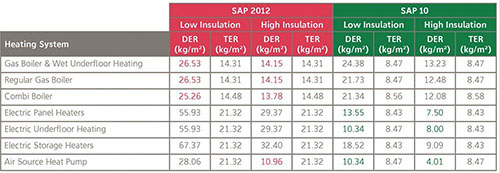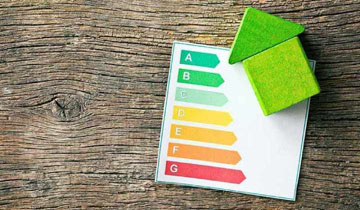5 min read
How SAP 10 will impact the heating industry
SAP 10 and its iterations has heavily featured in heating industry news since early 2018 and there is good reason for that. The latest iteration of...
4 min read
 Chris Hedges
:
Feb 14, 2022
Chris Hedges
:
Feb 14, 2022

The subject of domestic heating continues to be a popular subject. From the inevitable increase in fuel bills to the contribution of home heating on the environment. The amount of carbon emissions produced by heating systems needs to be reduced in order to meet the net-zero goal set by the Government. In fact, with 14% – 16% of greenhouse gas emissions coming from the way we heat our homes, decarbonisation of heating will play a huge part in reducing carbon emissions and hitting those targets. So, how do you heat your home which is kinder to the environment?
To help identify the more environmentally domestic heating systems we looked at the carbon emission rates of common heating systems which are specified in new builds. We ran both SAP 2012 and SAP 10 calculations to identify the best and worst as well as what the impact of the soon-to-be-released SAP 10 has on the results.
If you are not familiar with SAP, let us provide a brief explanation first. SAP was published in 1993, and it stands for Standard Assessment Procedure. This is a calculation methodology that has been set out by the Government to calculate the energy performance of dwellings. Any dwelling developed after the 1st April 2008 must have an EPC certificate which uses the full SAP methodology and it’s also a requirement of the Building Regulations for new builds.
SAP calculations are used to:
Without gaining a pass on SAP calculations, a property can‘t be sold or rented. In fact, building control will not provide final sign-off on any development if it doesn‘t pass which costs time and money.
Additionally, EPC certificates (rated A to G) are required for both new builds and extensions or conversions, SAP calculations are needed to produce them. If the EPC rating comes back rated equal to or lower than F, it is then illegal to rent out the property.
SAP 2012 was criticised for not accurately representing energy use in domestic dwellings. The calculations are based on different standard heating patterns attributed to weekdays and weekends which don’t correlate to real life use.
SAP 10 is an update to the existing SAP calculation methodology (SAP 2012). SAP 10.2 will be adopted for Building Regulation purposes in England from June this year. This follows several delays and iterations to fine tune it.
Big changes include:
We ran the SAP 2012 and SAP 10 calculations for a typical detached house to compare the Dwelling Carbon Dioxide Emission Rate (DER) and Target Carbon Dioxide Emission Rate (TER). These ratings determine whether a new dwelling passes or fails on its carbon emission targets set within Part L of the Building Regulations.
The domestic heating systems we compared:
About the property:
Type of property: Detached House
Floor area: 236.9m2
Low insulation: Values you would expect to see from a house from the 1940s-1960s
High insulation: Values you would see in a typical new build

Fig. 1: SAP 2012 & SAP 10 Dwelling Carbon Dioxide Emission Rate (DER) for a LOW insulated detached dwelling

Fig 2: SAP 2012 & SAP 10 Dwelling Carbon Dioxide Emission Rate (DER) for a HIGH insulated detached dwelling

Fig. 3: Raw data which includes additional Target Carbon Dioxide Emission Rate (TER) results
The proposed SAP 10 calculations will change the way heating systems are designed for residential developments to help to comply more easily with Building Regulations. This could mean that developers will lean towards air or ground source heat pumps which helps to explain, in part, their rise in popularity when specifying heating systems for new build projects. Electric panel heaters and/or electric underfloor heating used as a primary heat source are expected to boom too as a result of the changes to the new SAP calculations. High demand electric systems may require 3 phase systems and or the likes of solar PV to be considered as part of the heating specification, especially when considering electric boilers and more integrated electric systems for large properties.
For retailers who sell heating systems they would see an increase in demand for electric heating as industry adapts to modernising the way new homes are heated to help reduce CO2 emissions.
Construction methods will also be influenced. This could include an increase in more modular offsite construction such as bathroom pods, which lends itself to electric underfloor heating because it can be easily installed offsite and simply ‘plugged in‘ when onsite.
The construction industry will adapt and heating technology will continue to be developed to be much more sympathetic to the environment. For now, and to answer the question as to what is the best way to heat your home which is kinder to the environment? electric systems are starting to become a no-brainer.
Should you decide that you would like to add some electric heating into the mix, our team are always on stand-by to help walk you through the options available to you. Simply, get in touch.

5 min read
SAP 10 and its iterations has heavily featured in heating industry news since early 2018 and there is good reason for that. The latest iteration of...

6 min read
Probably if you’ve ended up at this blog, you’ve already decided to use electric underfloor heating in your project.

4 min read
Launched in the latter part of 2022, the report ‘Working towards Net Zero’ sheds light on the UK construction industry’s attitudes toward direct...